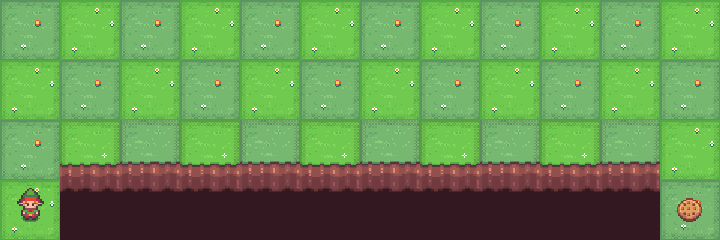Cliff Walking#

This environment is part of the Toy Text environments which contains general information about the environment.
Action Space |
|
Observation Space |
|
import |
|
Cliff walking involves crossing a gridworld from start to goal while avoiding falling off a cliff.
Description#
The game starts with the player at location [3, 0] of the 4x12 grid world with the goal located at [3, 11]. If the player reaches the goal the episode ends.
A cliff runs along [3, 1..10]. If the player moves to a cliff location it returns to the start location.
The player makes moves until they reach the goal.
Adapted from Example 6.6 (page 132) from Reinforcement Learning: An Introduction by Sutton and Barto [1].
With inspiration from: https://github.com/dennybritz/reinforcement-learning/blob/master/lib/envs/cliff_walking.py
Action Space#
The action shape is (1,) in the range {0, 3} indicating
which direction to move the player.
0: Move up
1: Move right
2: Move down
3: Move left
Observation Space#
There are 3 x 12 + 1 possible states. The player cannot be at the cliff, nor at the goal as the latter results in the end of the episode. What remains are all the positions of the first 3 rows plus the bottom-left cell.
The observation is a value representing the player’s current position as current_row * ncols + current_col (where both the row and col start at 0).
For example, the starting position can be calculated as follows: 3 * 12 + 0 = 36.
The observation is returned as an int().
Starting State#
The episode starts with the player in state [36] (location [3, 0]).
Reward#
Each time step incurs -1 reward, unless the player stepped into the cliff, which incurs -100 reward.
Episode End#
The episode terminates when the player enters state [47] (location [3, 11]).
Information#
step() and reset() return a dict with the following keys:
“p” - transition proability for the state.
As cliff walking is not stochastic, the transition probability returned always 1.0.
Arguments#
import gymnasium as gym
gym.make('CliffWalking-v0')
References#
[1] R. Sutton and A. Barto, “Reinforcement Learning: An Introduction” 2020. [Online]. Available: http://www.incompleteideas.net/book/RLbook2020.pdf
Version History#
v0: Initial version release


